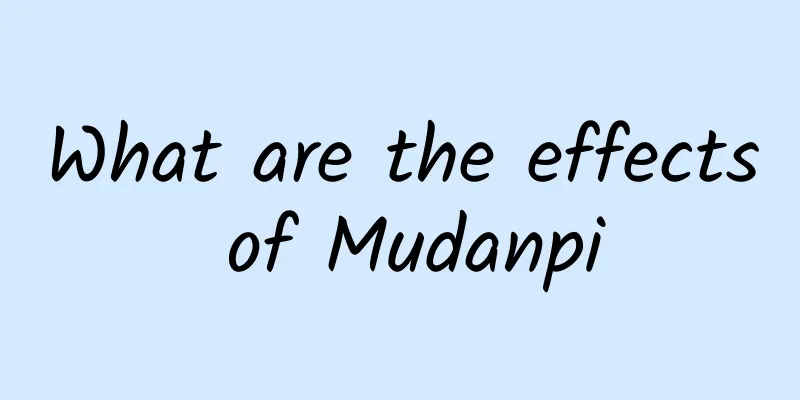What are the effects of Mudanpi

|
Mudanpi is the name of a traditional Chinese medicinal material. It is mainly made from the dried root bark of peony. The roots can be dug up in the autumn of each year. After removing the mud and some fine roots, the roots are peeled and dried. Modern scientific research has found that the ingredients contained in peony bark have anti-inflammatory, sedative, cooling and analgesic, diuretic and anti-ulcer effects. However, people with blood deficiency, cold syndrome, pregnant women or people with heavy menstrual flow are not suitable for taking peony bark. The efficacy of peony bark Clears away heat; promotes blood circulation and relieves blood stasis. It is used for febrile diseases with heat entering the blood; rash; vomiting and bleeding; hot eyes; fever in the late stage of pathogenic bacteria; hot flashes due to yin deficiency and bone steaming; blood stasis and amenorrhea; dysmenorrhea; carbuncle, swelling and sore; pain caused by falls and injuries; rheumatism and heat arthralgia The role of peony bark 1. Effects on cardiovascular system: Cortex Moutan can increase coronary blood flow, reduce cardiac output and decrease left ventricular work in anesthetized dogs. It has a significant protective effect on experimental myocardial ischemia, which lasts for a long time and reduces myocardial oxygen consumption. 2. Effects on the central nervous system: Paeonol has an antipyretic effect on fever in mice caused by oral administration of typhoid and paratyphoid vaccines, and can reduce the body temperature of normal mice. Oral administration of paeonol can inhibit the writhing reaction and tail tenderness reaction of mice caused by intraperitoneal injection of acetic acid, counteract the hyperactivity of mice caused by caffeine, significantly prolong the sleep time of mice induced by cyclohexylbarbital sodium, and at high doses can cause the righting reflex of mice to disappear. It can significantly counteract the convulsions caused by pentylenetetrazol, strychnine, nicotinic acid and electric shock. The sites of action are the midbrain reticular formation and thalamus. 3. Anti-inflammatory effect: Intragastric administration of paeonol can inhibit the plantar edema of rats caused by dextran, acetic acid or carrageenan, and can inhibit the enhanced permeability of mouse abdominal cavity or guinea pig skin capillaries caused by acetic acid or 5-hydroxytryptamine, and inhibit the occurrence of stress ulcers in mice. 4. Antibacterial effect: In vitro experiments show that the decoction of moutan bark has a strong antibacterial effect on Bacillus subtilis, Escherichia coli, Salmonella typhi, Salmonella paratyphi, Proteus, Pseudomonas aeruginosa, Staphylococcus aureus, hemolytic Streptococcus, Pneumococcus, Vibrio cholerae, etc. The decoction of peony leaves has a significant antibacterial effect on Shigella dysenteriae, Pseudomonas aeruginosa and Staphylococcus aureus, and its active ingredient is gallic acid. 5. Anticoagulant effect: In vitro experiments on human platelets showed that both the water extract of Paeonia lactiflora and Paeoniflorin could inhibit the production of thromboxane A2 from platelet arachidonic acid, thereby inhibiting platelet aggregation. This was due to the inhibition of the cyclooxygenase reaction from arachidonic acid to prostate H2. The methanol extract of Paeonia lactiflora has the effect of inhibiting experimental thrombosis caused by endotoxin. 6. Impact on the immune system: Gavage of moutan bark, paeonol, paeoniflorin, oxidized paeoniflorin, and benzoylpeoniflorin to mice respectively promoted the clearance rate of intravenously injected carbon particles in the blood, even when the function of the mononuclear macrophage system was at a low level. Microscopic examination showed that the phagocytic capacity of Kupffer cells in the liver and macrophages in the spleen was enhanced. 7. Effects on lipid metabolism: The bark of moutan and the paeonol and paeoniflorin it contains have an inhibitory effect on the lipolysis of adipocytes caused by adrenaline; the water extract of the bark of moutan can increase the production of fat from glucose in adipocytes, and significantly increase the production of fat from glucose caused by insulin. |
<<: What are the effects of plant enzymes?
>>: What are the effects of eating lotus seeds together?
Recommend
What is the medicinal value of small-leaf red sandalwood?
Everyone knows about rosewood. Generally, we only...
The efficacy and function of Laoqiangu
Lao Qiang Gu is a very good medicinal material. I...
What are the traditional Chinese medicines for liver protection and nourishment?
Alcohol can cause great harm to our liver. You ca...
The efficacy and function of Astragalus
In fact, the occurrence of many human diseases is...
The efficacy and function of water ball flower root
Water lily root is a very common Chinese medicine...
What are the medicinal values of black bamboo?
In fact, there are many types of bamboo. The tiss...
It’s no exaggeration, people can really be “angered to death”!
Review expert: Wu Xinsheng, deputy chief physicia...
Can AI meet human emotional needs?
With the continuous advancement of science and te...
The cold wave is coming! Have the long johns you bought arrived?
This article was first published by Hunzhi (WeCha...
The efficacy and function of Cornus officinalis[picture]
What are the functions of Cornus officinalis [pic...
Can Glucophage be taken for a long time?
With the continuous improvement of real society, ...
Is it necessary to build giant starships so that humans can fly out of the solar system and into deep space?
Almost all science fiction movies and TV shows de...
Can I drink American ginseng tea during menstruation?
American ginseng is a tonic medicinal material th...
The efficacy and function of the root of Tung oil tree
Most Chinese medicinal materials have good effect...
Today is Laba Festival丨The Laba garlic turns green, is it really spoiled?
Today is the eighth day of the twelfth lunar mont...

![The efficacy and function of wild ginseng[picture]](/upload/images/67ca1356aec63.webp)







![Black ginseng[picture] efficacy and function](/upload/images/67ca5de6b8f24.webp)